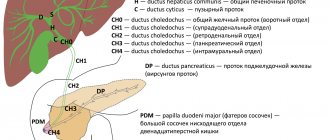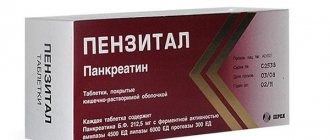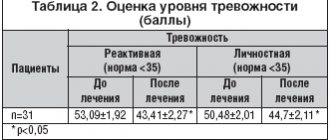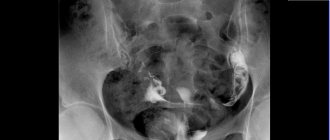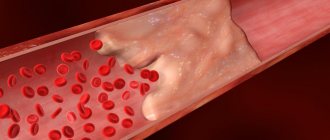Gastric outlet stenosis is a condition accompanied by mechanical obstruction (closure) of the pyloric portion of the stomach or duodenum.
Causes of mechanical obstruction
- Malignant tumors such as cancer of the antrum, pylorus and duodenum. In addition, compression of the outlet section by a tumor of the head of the pancreas or bile ducts, as well as enlarged lymph nodes, for example, with lymphoma, is possible.
- Peptic ulcer of the stomach and duodenum, both in the acute stage (due to inflammation of the walls and severe swelling), and in the chronic stage with the formation of coarse scar tissue in place of previously existing ulcers of the pyloric canal or duodenum.
- More rare causes of gastric outlet stenosis may be Crohn's disease, burn stenosis after consuming aggressive liquids (acid or alkali), or chronic pancreatitis.
Clinical picture
The most characteristic signs of gastric outlet stenosis are:
- Quick feeling of fullness while eating;
- Loss of body weight;
- Nausea and vomiting after eating (without bile!);
- Belching of air with an acidic taste;
- Discomfort and pain in the epigastrium;
- Feeling of fullness in the stomach;
- “Splashing noise” is caused by jerky movements of the abdominal wall in the epigastric region with the tips of 2-3 fingers. “Splashing noise” appears when there is a significant amount of liquid and gas in the stomach (more clearly detected using a phonendoscope).
What is pyloric insufficiency?
This is a disease in which the muscle ring of the pylorus does not close completely, resulting in a disruption of the digestive process. Pathology is usually diagnosed:
- in older people due to weakening muscle tone throughout the body;
- in pregnant women against the background of hormonal changes;
- as a congenital pathology requiring surgical intervention.
Pyloric insufficiency may occur due to:
- pathologies of the nervous system;
- neoplasms in the digestive organs;
- gastritis, duodenitis and other inflammatory diseases;
- frequent overeating, improper diet;
- hormonal changes.
A healthy pylorus protects the sensitive intestinal mucosa from the effects of gastric juice. In addition, the food has time to break down and form chyme.
Diagnostics
Diagnostic criteria for gastric outlet stenosis:
- Clinical – the presence of symptoms of impaired gastric emptying, weight loss, signs of water and electrolyte imbalance.
- Laboratory tests - increased hematocrit, signs of metabolic hypochloremic alkalosis, hypokalemia, hypochloremia, decreased concentration of ionized calcium, hypoproteinemia, signs of metabolic alkalosis, in severe cases - azotemia.
- Instrumental - probing the stomach - evacuation of a large amount of contents with a sour or “rotten egg” smell.
- Endoscopic - narrowing of the lumen of the pyloric part of the stomach and the initial part of the duodenum.
- X-ray – slowdown or lack of evacuation of contrast from the stomach, retention of contrast in the stomach.
Photo 1: X-ray of the esophagus and stomach with barium for stenosis of the gastric outlet. Photo 2: endoscopic picture of pyloric stenosis of ulcerative etiology.
Signs and symptoms[edit]
Infants with this condition usually present anytime during the first weeks to 6 months of life with progressive vomiting. Vomiting affects first-born children more often in males than in females, by a ratio of 4 to 1. [7] Vomiting is often described as non-bilious vomiting ("non-bilious") and "projectile vomiting" because it is more forceful than normal regurgitation (gastroesophageal reflux) seen at this age. Some babies experience poor feeding and weight loss, but others experience normal weight gain. Dehydration may occur, causing the baby to cry without tears and produce fewer wet or dirty diapers due to lack of urination for several hours or several days. Symptoms usually appear between 3 and 12 weeks of age. Findings include epigastric fullness with visible peristalsis in the upper abdomen from left to right. [8] Constant hunger, belching, and colic are other possible signs that your baby may not be able to eat properly.
Classification
By etiology:
- due to benign diseases;
- due to malignant diseases.
By stage of development:
- compensated;
- subcompensated;
- decompensated.
Complications:
- hypovolemic shock;
- acute gastrointestinal bleeding (ulcerative or mucosal ruptures due to repeated vomiting);
- perforation of an ulcer or tumor;
- spontaneous rupture of the stomach.
Treatment of stenosis of the stomach and duodenum
Treatment is always surgical. Before the operation, the metabolism is adjusted. To do this, the patient is injected with solutions of dextran, albumin, glucose, saline solution, and electrolyte solution. In addition, it is necessary to constantly remove the contents of the stomach through a tube to reduce pressure on its walls. To replenish energy losses, patients are prescribed parenteral nutrition. About a week after such preparation, the operation is performed. This may be gastric resection, expansion of the duodenum, vagotomy, etc.
The prognosis depends on the stage of the disease. With late diagnosis, complications that are incompatible with life develop.
Treatment
Treatment of gastric stenosis is surgical. The goal of surgical treatment of gastric outlet stenosis is to eliminate the stenosis and restore passage through the stomach and duodenum.
Patients with sub- and decompensated stenosis require comprehensive preoperative preparation, including correction of water-electrolyte metabolism, protein composition, volemic disorders, and activity of the cardiovascular system; as well as gastric lavage and decompression.
Patients without pronounced disorders of gastric motility (stages of developing and compensated stenosis) can be operated on after a relatively short (5-7 days) period of preoperative preparation (anti-ulcer therapy, gastric decompression).
The choice of surgical intervention is determined by the disease that led to the formation of obstruction of the gastric outlet tract.
- In case of malignant etiology of the disease, examination and treatment are carried out in accordance with oncological recommendations for gastric cancer. For tumor stenosis, subtotal proximal resection or gastrectomy in combination with lymphadenectomy is performed.
- For cicatricial stenoses of benign origin, it is necessary to perform either organ-preserving drainage operations (pyloroplasty in various modifications, gastrojejunostomy bypass) or distal gastrectomy. In case of ulcerative stenosis, a standard resection of 2/3 of the stomach is performed with an anastomosis according to Billroth 1 or Billroth 2 in various modifications, depending on the conditions for the anastomosis and the formation of the duodenal stump. All surgical treatment options are possible using minimally invasive technologies in the absence of contraindications.
Pyloroplasty according to Heineke-Mikulicz
Pyloric stenosis in children
The surgical method is effective for treating pyloric stenosis in children. The operation is carried out 1-3 days after an accurate diagnosis has been established. A contraindication is not too much exhaustion of the child, since without surgery, death is most likely.
If the child is very malnourished, it is important to restore water and salt metabolism before surgery. Over the course of 2-4 days, the child receives 2 to 4 blood or plasma transfusions (amount of 10 ml per 1 kg). Ringer's solutions, physiological and 5% glucose are administered subcutaneously, intravenously, and in enemas. A sick child should receive at least 500-600 ml of fluid per day.
If the baby has concomitant diseases (otitis media, pneumonia), antibiotics are also important for treatment. Before the operation, a blood transfusion and a general bath are performed, and the child is not given water or food from 24:00. If the regimen is followed to the end, then before the operation there will be no need to rinse the child’s stomach. The best approach to the stomach and pylorus is through a midline incision from the xiphoid process of the sternum, 4-5 cm long. When the incision is made correctly, the liver prevents intestinal eventration.
The operation of cutting the pylorus in children is called pylorotomy. It is carried out according to the Frede-Ramstedt method. The essence of the operation is a longitudinal dissection of the seromuscular layer of the pylorus along an avascular line without opening the mucous membrane. After the incision, the edges of the pyloric wound are pulled apart with tweezers until the mucous membrane is completely released and bulges into the pyloric wound. Bleeding is usually minor. The edges of the pyloric wound are not sutured.
Interrupted catgut sutures with the addition of 2-3 silk are applied to the peritoneum along with the aponeurosis. The skin is sutured with a continuous entwining catgut suture, which promotes better hemostasis. After the operation, a blood transfusion is performed. 2 hours after the operation, the child needs to be given 10 ml of a 5% glucose solution, another 1 hour after this, feeding with expressed breast milk begins every 2 hours with a six-hour break at night.
On the first day, a single dose of milk to a child should be from 20 to 30 ml. If there is vomiting or injury to the mucous membrane, the amount of milk is 5-10 ml. Every day the daily dosage of milk for a sick child is increased by 100 ml. If there is no vomiting on the fifth or sixth day, the child is applied to the breast twice for 5 minutes each. From the 7th day you can breastfeed with breaks of 3 hours.
After surgery, therapy to combat dehydration, exhaustion and salt metabolism disorders is important. Very soon after the operation, all symptoms disappear - both those visible on the x-ray and those that are felt physically. The prognosis is favorable if the operation is performed correctly. The child develops according to his age, and no gastrointestinal disturbances are observed.
Possible complications (before surgery) :
- aspiration syndrome
- ulcerative lesions of the gastric mucosa
- disturbance of the electrolyte composition of the blood and dehydration (lack of sodium, potassium, chlorine, calcium in the body)
If diagnosis and surgery are not carried out in time, it can result in death. Children suffocate, blocking the respiratory passages with vomit, or become severely dehydrated, in which the body is no longer able to function. If treatment is started late, the child may be delayed in growth and development, since the body will not have enough vitamins, nutrients, and minerals.
Treatment in the department of thoracoabdominal surgery and oncology
Treatment in the department is carried out under the programs of compulsory medical insurance, voluntary medical insurance, VMP, as well as on a commercial basis. Read how to get treatment at the Department of Thoracoabdominal Surgery and Oncology of the Russian Scientific Center for Surgery.
To schedule a consultation, call:
+7 (499) 248 13 91 +7 (903) 728 24 52 +7 (499) 248 15 55
Submit a request for a consultation by filling out the form on our website and attaching the necessary documents.
Epidemiology[edit]
Men are affected more often than women, first-born males are affected approximately four times more often, and there is a genetic predisposition to the disease. [19] It is usually associated with people of Scandinavian descent and has multifactorial patterns of inheritance. [9] Pyloric stenosis is more common in Caucasians than in Hispanics, blacks, or Asians. The incidence is 2.4 per 1000 live births in Caucasians, 1.8 in Hispanics, 0.7 in blacks, and 0.6 in Asians. It is also less common among children of mixed-race parents. [20] Caucasian infants with blood type B or O are more susceptible to the disease than children of other types. [19]
Infants exposed to erythromycin are at increased risk of developing hypertrophic pyloric stenosis, especially when the drug is administered after approximately two weeks of life [21] and possibly during late pregnancy and through breast milk in the first two weeks of life. [22]
Causes
To date, the reasons why stenosis of the stomach (its pyloric section) occurs are not known. There are various theories:
- Spasmogenic, according to which spasm occurs primarily, against the background of which hypertrophy .
- Dualistic - spasm and hypertrophy develop simultaneously.
- Neurogenic.
- Psychogenic. There is evidence that pyloric stenosis is more common in children whose mothers were in a state of nervous stress in the third trimester.
- Hereditary.
- Hormonal.
erythromycin and azithromycin has not been fully confirmed .
However, it has been proven that this condition is associated with factors:
- male gender (5 times more common in boys);
- smoking during pregnancy;
- lack of folic acid and B vitamins during pregnancy;
- premature birth;
- various congenital defects;
- delivery using cesarean section;
- low weight of the newborn;
- artificial feeding in the first months; at the same time, the risk of developing pyloric stenosis increases 4.5 times.
This is because formula contains a higher concentration of casein proteins compared to breast milk and does not contain enzymes that facilitate the digestion of proteins. All these factors complicate the digestion process in infants.
Changes in the pylorus always begin with pylorospasm . In older children and adolescents, the causes of this functional state are as follows:
- gastritis with high acidity with frequent exacerbations;
- peptic ulcer (stomach and duodenum);
- chronic intestinal diseases;
- dysbacteriosis;
- deficiency of B vitamins;
- biliary dyskinesia;
- physical overload;
- stress;
- hysterical neurosis .
Secondary (acquired) pylorospasm in adults can be caused by:
- organic pathology of the gastrointestinal tract (for example, peptic ulcer , chronic antral gastritis , cholecystitis , hiatal hernia, cholelithiasis , hyperacid gastritis );
- cicatricial changes after a chemical burn.
Also in adults, primary (neurogenic) pylorospasm is noted, the cause of which is:
- neuroses;
- hysteria;
- zinc and lead intoxication;
- mental stress;
- emotionally stressful situations;
- addiction.
If we talk about the factors that provoke pylorospasm in adults, then it is worth noting nutritional disorders: overeating, irregular meals, changes in diet, excessive consumption of coarse fiber and carbohydrates. Food allergies and various exogenous factors are also important: vibration, ionizing radiation, taking medications (NSAIDs, glucocorticoids), high ambient temperature, smoking and occupational intoxications.
Pylorospasm and pyloric stenosis are links in the same chain of pyloric motility disorders: first, pyloric spasm occurs, which leads to muscle hypertrophy and pyloric stenosis.
Diet
Diet table No. 1
- Efficacy: therapeutic effect after 3 weeks
- Terms: 2 months or more
- Cost of products: 1500 - 1600 rubles. in Week
The nutrition of children was discussed above; for adults with pylorospasm, mechanically and chemically gentle nutrition is recommended. Food should be taken warm. Avoid hot and cold foods rich in fiber. It is not advisable to consume spicy foods and seasonings, coffee, carbonated drinks, which can intensify the spasm. Table No. 1 meets all requirements .
Pathogenesis
From a pathogenetic point of view, it is associated with hypertrophy of the circular muscles of the pylorus and partial muscle hyperplasia. In the prenatal period, partial excessive growth of the stomach anlage occurs from the mesenchyme in the pyloric region, from which the muscle elements differentiate. However, hypertrophy of the muscle layer develops postnatally. The anterior and upper walls of the exit section are the most thickened, as a result of which the pylorus takes on the shape of a spindle. From the beginning, the child does not experience inflammation or swelling of the pyloric mucosa. The addition of mucosal edema to the existing hypertrophy and hyperplasia of the pyloric muscles is manifested by increasing obstruction of the pyloric region.
Many believe that a spastic component is added (that is, spasm is secondary); some authors argue that spasm and hypertrophy appear simultaneously. Among the causes of spasm and hypertrophy are the immaturity of the autonomic regulation of gastric function. The visceral organ is under the control of regulatory influences. The pathogenesis of spasm is due to disruption of interactions between the diseased organ and regulatory systems. From the side of the narrowed pylorus, signals enter the cerebral cortex, and in response, return impulses go to the pylorus. The cerebral cortex constantly receives signals that disrupt its regulatory function. A vicious circle is created: impulses from the center disrupt the function of the gatekeeper, and impulses from it to the center deepen the damage to the regulatory system. Breaking the chain restores normal relationships.
Pylorospasm is associated with increased tone of the sympathetic nervous system. The resulting prolonged spasm of the pylorus muscles makes it difficult to empty the stomach. Hypertonicity can be caused by fetal hypoxia , posthypoxic encephalopathy , increased intracranial pressure and hydrocephalic syndrome .
Forecast
Pylorospasm with age, as the nervous system improves, regurgitation is reduced, vomiting disappears by 5-6 months. Vomiting in some children may resume with a fever, a cold, or after a conflict situation.
Pyloric stenosis can be treated with surgery. Pyloromyotomy shows good long-term results: children develop well, and X-ray control indicates normal gastric function and good emptying. There are no relapses after the operation. Mortality with proper surgical treatment is minimal - it is observed only among patients who are operated on late and their death is associated with exhaustion and its attendant complications.
Prevention
Prevention of the disease has not been developed, but taking into account risk factors, it can be assumed that the following general measures will be effective:
- A rational and balanced diet for a pregnant woman, including folic acid , vitamins and microelements.
- Minimizing stressful situations and psycho-emotional stress during pregnancy.
- Compliance with the work and rest schedule of a pregnant woman.
- Observation at the antenatal clinic to identify pregnancy pathologies.
- Normalization of the child's feeding regimen in order to eliminate overfeeding and regurgitation.
- Creating a prosperous environment for the child.
- For adults with pylorospasm, it is important to eliminate psycho-emotional stress and stress, and establish adequate sleep and rest.
List of sources
- Nagornaya N.V., Limarenko M.P., Bordyugova E.V. Rational therapy of functional gastrointestinal disorders in young children. News of medicine and pharmacy. 2008. 16(255) - pp. 14-15.
- Khavkin A.I. Functional disorders of the gastrointestinal tract in young children. M., 2000. 71 p.
- Zaprudnov A. M. Handbook of pediatric gastroenterology. M., 1995. pp. 25–26.
- Botvinyev O.K. Turina I.E. Barmaver S.Z. Difficulties in diagnosing congenital pyloric stenosis in children. Russian pediatric journal. 2000.-N 6.-P.45-46.
- Vasilyeva, N.P. Possibilities of echography in congenital pyloric stenosis / N.P. Vasilyeva, M.Kh. Arslanova, T.M. Shakhmaeva // Ultrasound diagnostics. – 1997. – No. 4. – P. 11.
Signs of esophageal stenosis
There are several signs by which esophageal stenosis can be diagnosed, these traditionally include the following:
- unpleasant pain when eating, and the pain is felt as the food moves in the esophagus;
- salivation is constantly observed;
- one feels nauseated, often vomiting and belching.
There are several degrees of damage to esophageal stenosis:
- First degree. Problems arise from time to time when swallowing solid foods. In general, the condition is satisfactory.
- Second degree. Food can pass through the esophagus only in semi-liquid form.
- Third degree. Only liquid food can pass through the esophagus.
- Fourth degree. It is very difficult to swallow even saliva and water.

